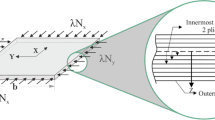Abstract
Stacking sequence optimization (SSO) of laminate will greatly improve its mechanical properties without weight penalty. In this paper, a novel permutation discrete particle swarm optimization (PDPSO) method was proposed to perform SSO. To improve the efficiency of the algorithm, the concepts and techniques of valid/invalid exchange, checking memory and Self-escape were introduced into the PDPSO. In total 11 examples were presented. First, eight examples were carried out by employing the proposed method. The results show that the computational efficiency of PDPSO is greatly improved compared with standard discrete particle swarm optimization (SDPSO), and is comparable with that of gene rank crossover (GR) and partially mapped crossover (PMX). Then, three extra examples were presented, in which the outermost plies in the optimum design are not ±45° plies. The results show that the PDPSO has better stability and potential which demonstrate the better performance of PDPSO for laminates.
Similar content being viewed by others
References
Bloomfield M, Herencia JE, Weaver PM (2008) Optimization of anisotropic laminated composite plates incorporating non-conventional ply orientations. In: Proceeding of the 49th AIAA/ASME/ASCE/AHS/ASC structures, structural dynamics, and materials conference. Schaumburg, IL
Eberhart RC, Kennedy J (1995) A new optimizer using particle swarm theory. In: Sixth international symposium on micro machine and human science (MHS’95). Nagoya, Japan, pp 39–43
Faggiani A, Falzon BG (2007) Optimization strategy for minimizing damage in postbuckling stiffened panels. AIAA J 45:2520–2528
Fourie PC, Groenwold AA (2001) The particle swarm algorithm in topology optimization. In: Proceedings of the fourth world congress of structural and multidisciplinary optimization. Dalian, pp 52–63
Herencia JE, Weaver PM, Friswell MI (2007) Optimization of long anisotropic laminated fiber composite panels with T-shaped stiffeners. AIAA J 45:2497–2509
Kameyama M, Fukunaga H (2007) Optimum design of composite plate wings for aeroelastic characteristics using lamination parameters. Comput Struct 85:213–224
Kathiravan R, Ganguli R (2007) Strength design of composite beam using gradient and particle swarm optimization. Compos Struct 81:471–479
Kennedy J, Eberhart RC (1997) A discrete binary version of the particle swarm algorithm. In: Proceedings of the world multiconference on systemics, cybernetics and informatics. Piscataway, NJ, pp 4104–4109
Li X, Tian P, Hua J, Zhong N (2006) a Hybrid discrete particle swarm optimization for travelling salesman problem. Lect Notes Comput Sci 4247:181–188
Liu B, Haftka RT, Akgün MA (2000a) Two-level composite wing structural optimization using response surfaces. Struct Multidisc Optim 20:87–96
Liu B, Haftka RT, Akgün MA, Todoroki A (2000b) Permutation genetic algorithm for stacking sequence design of composite laminates. Comput Methods Appl Mech Eng 186:357–372
Muc A, Gurba W (2001) Genetic algorithms and finite element analysis in optimization of composite structures. Compos Struct 54:275–281
Park JH, Hwang JH, Lee CS, Hwang W (2001) Stacking sequence design of composite laminates for maximum strength using genetic algorithms. Compos Struct 52:217–231
Rameshkumar K, Suresh RK, Mohanasundaram KM (2005) Discrete particle swarm optimization algorithm for permutation flow-shop scheduling to minimize makespan. Lect Notes Comput Sci 3612:572–581
Sciuva MD, Gherlone M, Lomario D (2003) Multiconstrained optimization of laminated and sandwich plates using evolutionary algorithms and higher-order plate theories. Compos Struct 59(1):149–154
Seresta O, Abdalla M, Gurdal Z (2006) Minimum weight design of composite structures with local postbuckling and blending constraints. AIAA paper 2006–1818
Shi YH, Eberhart RC (1998) A modified particle swarm optimizer. In: Proceedings of the IEEE international conference on evolutionary computation. Anchorage, AK, pp 69–73
Suresh S, Sujit PB, Rao AK (2007) Particle swarm optimization approach for multi-objective composite box-beam design. Compos Struct 81:598–605
Venter G, Sobieszczanski-Sobieski J (2004) Multidisciplinary optimization of a transport aircraft wing using particle swarm optimization. Struct Multidisc Optim 26:121–131
Walker M, Smith RE (2003) A technique for the multiobjective optimization of laminated composite structures using genetic algorithms and finite element analysis. Compos Struct 62:123–128
Whitney JM (1985) Structural analysis of laminated anisotropic plates. Technomic Publishing Company, Lancaste, pp 119–122
Author information
Authors and Affiliations
Corresponding author
Rights and permissions
About this article
Cite this article
Chang, N., Wang, W., Yang, W. et al. Ply stacking sequence optimization of composite laminate by permutation discrete particle swarm optimization. Struct Multidisc Optim 41, 179–187 (2010). https://doi.org/10.1007/s00158-009-0417-x
Received:
Revised:
Accepted:
Published:
Issue Date:
DOI: https://doi.org/10.1007/s00158-009-0417-x




